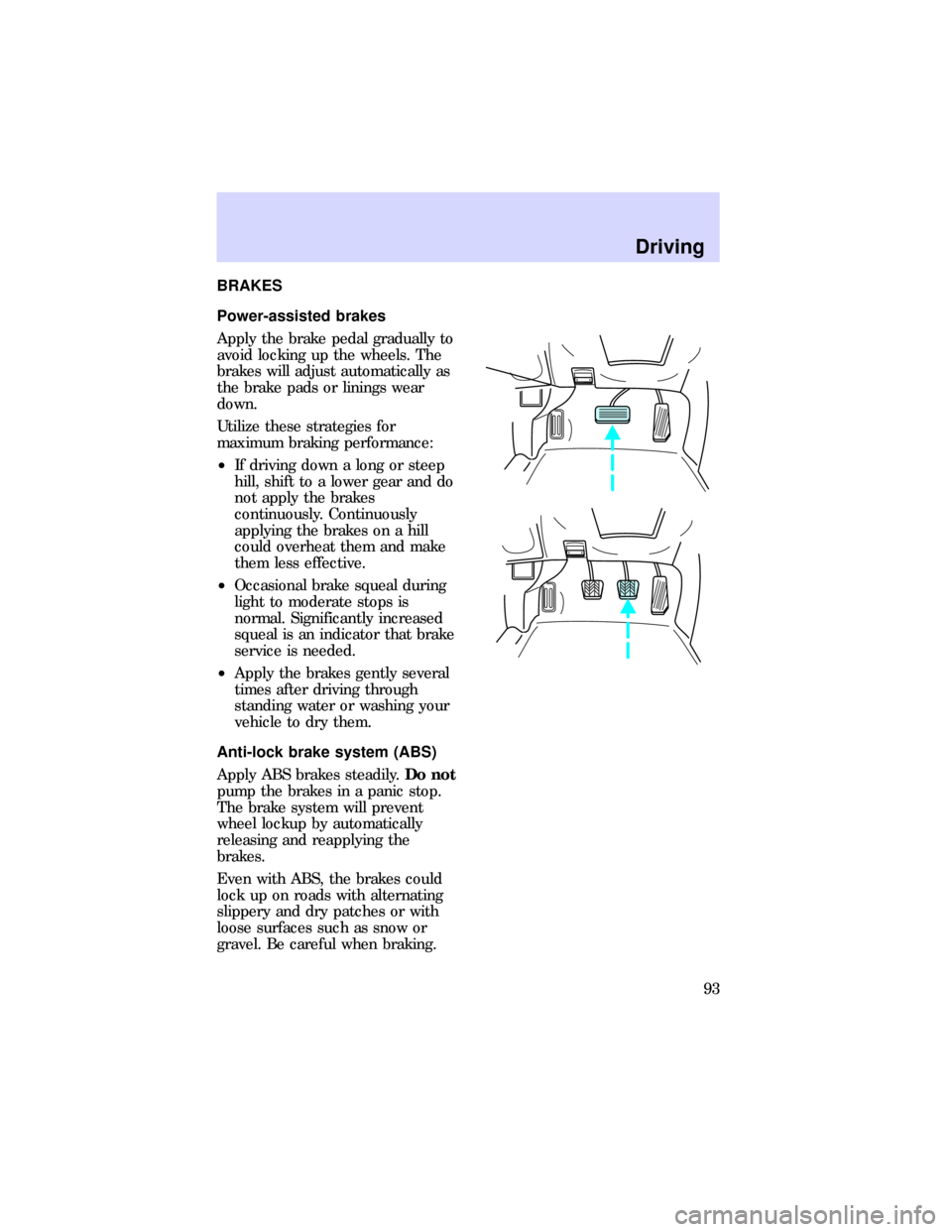Page 93 of 191

BRAKES
Power-assisted brakes
Apply the brake pedal gradually to
avoid locking up the wheels. The
brakes will adjust automatically as
the brake pads or linings wear
down.
Utilize these strategies for
maximum braking performance:
²If driving down a long or steep
hill, shift to a lower gear and do
not apply the brakes
continuously. Continuously
applying the brakes on a hill
could overheat them and make
them less effective.
²Occasional brake squeal during
light to moderate stops is
normal. Significantly increased
squeal is an indicator that brake
service is needed.
²Apply the brakes gently several
times after driving through
standing water or washing your
vehicle to dry them.
Anti-lock brake system (ABS)
Apply ABS brakes steadily.Do not
pump the brakes in a panic stop.
The brake system will prevent
wheel lockup by automatically
releasing and reapplying the
brakes.
Even with ABS, the brakes could
lock up on roads with alternating
slippery and dry patches or with
loose surfaces such as snow or
gravel. Be careful when braking.
Driving
93
Page 94 of 191
The ABS brake system conducts a
self-test each time the vehicle is
driven. A mechanical noise may be
heard while the system conducts
its self-test.
ABS warning light
TheABSlight in the instrument
cluster illuminates and remains
illuminated if an ABS fault is
detected. Have your vehicle
serviced by a qualified service
technician as soon as possible.
Normal braking operation is still
effective unless the
P!BRAKElight is
also illuminated.
Parking brake
The parking brake should be used
whenever the vehicle is parked.
To set the parking brake:
The parking brake is not designed
to stop a moving vehicle. However,
if the normal brakes fail, the
parking brake can be set to stop
the vehicle. The vehicle's stopping
distance will increase greatly and
vehicle steering response will be
limited.
When the ignition is turned to ON,
the
P!BRAKElight in the instrument
cluster illuminates and remains
illuminated until the parking brake
is released.
Driving
94
Page 105 of 191

Driving while towing a trailer
Do not drive faster than 88 km/h
(55 mph) while towing a 454 kg
(1000 lb) trailer. Do not drive
faster than 72 km/h (45 mph) with
any weight trailer while towing in
hilly country or on hot days.
Speed control (if equipped) may
not work properly while towing on
very long, steep grades.
If driving with an automatic
transaxle:
²use D or L rather than
Dwhile towing up or down
steep hills.
²anticipate stops and brake
gradually.
If driving with a manual transaxle:
²select a gear that avoids jerking
or excessive engine speed.
²avoid driving excessively in first
or second gear. In first or
second gear the trailer may be
too big or too heavily loaded for
the vehicle drivetrain.
²shift to a lower gear while
towing up or down steep hills.
²anticipate stops and brake
gradually.
Servicing while towing
If you tow a trailer for long
distances, your vehicle requires
more frequent service than a
vehicle not used for towing. Refer
to theService Guidefor more
information.
Driving
105
Page 107 of 191
USING THE HAZARD SWITCH
Use the hazard flashers to warn
traffic of vehicle problems:
²Slide the hazard switch to the
right to activate the hazard
flashers.
²Slide the hazard switch to the
left to deactivate the
continuously blinking flashers.
RESETTING THE FUEL PUMP
SHUT-OFF SWITCH
The fuel pump shut-off switch
stops the fuel pump when the
vehicle has been involved in a
collision or major jolt. If the
vehicle does not start, it is possible
that the fuel pump shut-off switch
needs to be reset.
If you see or smell fuel, do
not reset the switch or try
to start your vehicle. Have all
passengers get out of the vehicle
and call the local fire department
or a towing service.
To reset the fuel pump, press the
button on the switch. The switch is
located immediately below the hole
in the trunk side trim.
Roadside emergencies
107
Page 120 of 191
JUMP-STARTING A DISABLED
VEHICLE
The gases around the
battery can explode if
exposed to flames, sparks, or lit
smoking materials. An explosion
could result in injury or vehicle
damage.
To protect yourself when
charging a battery, always
shield your face and eyes. Make
sure that you can breathe fresh
air.
Batteries contain sulfuric
acid which burns skin,
eyes, and clothing.
If the battery acid touches
someone's skin, eyes, or clothing,
immediately flush the area with
water for at least fifteen minutes.
If someone swallows acid, have
him or her drink lots of milk or
water first, then Milk of Magnesia,
a beaten egg, or vegetable oil.
Consult a physician immediately.
To avoid damage or injury,
follow these directions in
the order they are given. If in
doubt, call for road service.
Before jump-starting a vehicle:
²make sure the booster battery
vehicle has a 12-volt starting
Roadside emergencies
120
Page 124 of 191

SERVICE RECOMMENDATIONS
Whenever possible, Ford has
designed parts that do not require
servicing. However when servicing
is required, Ford's goal is to make
servicing your vehicle as easy as
possible. To help you:
²We highlight do-it-yourself items
in the engine compartment for
easy location.
²Often, parts (such as the
headlamp bulbs) may be
replaced without tools.
²We provide you with aService
Guidethat makes tracking
routine service of your vehicle
easy.
If your vehicle requires
professional servicing, your
dealership can provide the
necessary parts and service. Check
theWarranty Information Guide
to find out what parts and services
are covered. Use only
recommended fuels, lubricants,
fluids, and service parts
conforming to Ford specifications.
Motorcraft parts are designed and
built to provide the best
performance in your vehicle.
Precautions for servicing your
vehicle
Be particularly careful when
inspecting or servicing your
vehicle. Here are some general
precautions for your safety:
Maintenance and care
124
Page 130 of 191
CHECKING AND ADDING
ENGINE OIL
Use SAE 5W-30 motor oil
CERTIFIED FOR GASOLINE
ENGINES by the American
Petroleum Institute. Look for the
certification Ð Ford specification
WSS-M2C153-F.
Additional engine oil additives, oil
treatments, or engine treatments
are never needed and could, under
certain conditions, lead to engine
damage which is not covered by
your Warranty.
Changing the engine oil and oil
filter
Change the engine oil and oil filter
per the following, whichever
occurs first.
5,000 MILES (8,000 KM) OR 6 MONTHS
NORMAL SCHEDULE
3,000 MILES (5,000 KM) OR 3 MONTHS
SEVERE DUTY SCHEDULE
EXTENSIVE IDLING
TRAILER TOWING
DRIVING IN SEVERE DUST
POLICE, TAXI, OR DELIVERY
Oil change intervals
Refer to theService Guide
booklet for additional information.
Checking the engine oil
Check the engine oil every time
you fuel your vehicle.
Maintenance and care
130
Page 139 of 191
CHECKING AND ADDING
POWER STEERING FLUID
Check the power steering fluid at
least twice a year by completing
the following steps:
1. Start the engine.
2. When the engine coolant
temperature gauge reaches the
normal zone, turn off the engine.
3. Visually inspect the fluid level in
the power steering reservoir.
4. If necessary, add power steering
fluid until the fluid level reaches
MAX. Do not overfill the power
steering reservoir.
²As a maintenance precaution,
visually inspect the lines and
hoses of the power steering
system for leaks and damage.
²If new fluid is frequently
required, consult a qualified
service technician.
CHECKING AND ADDING
TRANSAXLE FLUID
Checking and adding automatic
transaxle fluid
Check the automatic transaxle
fluid according to the owner
maintenance checks in theService
Guide.
ON
II
ACC
I
LOCK
0
START
III
C
H
Maintenance and care
139